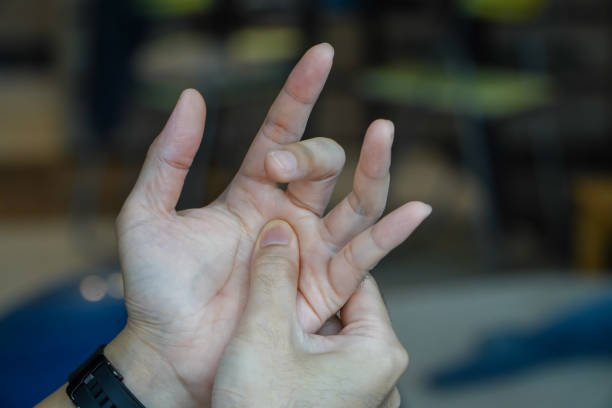Trigger finger, a condition often associated with repetitive hand movements, can pose significant challenges for athletes who depend on precise hand function for peak performance. This blog explores the causes, effects, and recovery strategies surrounding this condition, with a specific focus on a Famous Athlete with Trigger Finger who battled through it. Whether you’re an athlete, sports enthusiast, or health-conscious reader, this guide offers valuable insights into the complexities of trigger finger in the sporting world.
Table of Contents
What Is Trigger Finger? A Quick Overview
Trigger finger, medically known as stenosing tenosynovitis, is a condition where the tendons in the fingers or thumb become inflamed, leading to pain and stiffness. This inflammation causes the tendon to catch or lock when bending or straightening the finger. It is often accompanied by a clicking sensation, akin to pulling and releasing a trigger—hence the name.
The condition arises when the flexor tendons, which control finger movement, become restricted within their sheath due to repetitive strain or overuse. Trigger finger is most commonly observed in professions and activities requiring repeated gripping or manual effort, making athletes more vulnerable. Left untreated, it can significantly impair finger mobility and strength, hampering daily activities and athletic performance.
Early diagnosis is critical. Symptoms include pain at the base of the affected digit, swelling, and occasionally a visible nodule on the palm. When untreated, the condition may progress to locked finger joints, which significantly impair hand function.
How Trigger Finger Affects Athletes’ Performance
Athletes are heavily reliant on precise motor skills, especially in disciplines requiring frequent use of hands and fingers. Trigger finger can severely hinder their ability to grip, throw, or catch, key actions in sports such as baseball, tennis, rock climbing, or gymnastics. The unpredictable locking of the affected finger disrupts smooth movements, causing frustration and risking further injury.
For athletes, trigger finger is more than a localized issue; it diminishes confidence. Knowing that a finger may unexpectedly lock mid-motion can make athletes cautious or overly reliant on the uninjured hand, disrupting overall coordination. This imbalance can cascade into other injuries, as the body compensates for the impaired limb.
Athletes with trigger finger may also experience delayed reaction times. For instance, a basketball player may struggle to maintain ball control, while a golfer could find their grip compromised during a swing. These challenges underscore the urgency of addressing trigger finger promptly to minimize its impact on performance.
Famous Athlete with Trigger Finger: Their Journey & Struggles
One high-profile case of trigger finger involves tennis legend Rafael Nadal, who experienced the condition during a critical juncture in his career. Although his dominant left hand, essential for his distinctive topspin style, was affected, Nadal initially masked his symptoms to stay competitive in professional matches. However, the growing pain during strokes and volleys forced him to make adjustments.
At the height of his struggle, Nadal reported difficulty maintaining his grip on the racquet, especially during extended rally points. He sought medical interventions and had to adapt his training schedule to prioritize rehabilitation. For Nadal, the challenge wasn’t just physical but also psychological, as he grappled with the possibility of losing his competitive edge.
Despite these hurdles, Nadal demonstrated the resilience that has defined his career. Through a combination of expert treatment and tailored recovery plans, he emerged stronger and resumed his winning ways. His story highlights the importance of addressing trigger finger head-on to maintain long-term athletic success.
What Causes Trigger Finger in Athletes?
Trigger finger is typically caused by repetitive strain or overuse of the hands and fingers. Athletes are at higher risk due to the repetitive gripping motions inherent in their training and gameplay. Sports like golf, tennis, and baseball involve sustained pressure on the flexor tendons, increasing the likelihood of inflammation within the tendon sheath.
Other contributing factors include improper technique, inadequate warm-ups, or using ill-fitted equipment, such as racquets or grips that place undue stress on the fingers. Additionally, athletes with pre-existing conditions like diabetes or rheumatoid arthritis may have an elevated risk of developing trigger finger, as these conditions weaken tendon health over time.
Micro-injuries to the tendon sheath, often overlooked due to their subtlety, can accumulate over time. Without sufficient rest or recovery, these injuries develop into full-blown inflammation, exacerbating the condition. Preventative measures and proper biomechanics are essential for minimizing the causes of trigger finger in an athletic setting.
Signs and Symptoms of Trigger Finger in Sports
For athletes, early signs of trigger finger may include discomfort or stiffness in a specific finger, especially after intense activity. The base of the finger may appear swollen, and athletes may notice difficulty straightening the finger without assistance. A hallmark symptom is the audible “click” or “pop” sound that occurs as the tendon moves.
Another indication is reduced grip strength, which can hinder essential skills like throwing or lifting. Over time, athletes may find themselves massaging the affected area more frequently to relieve discomfort or restore temporary mobility. If the condition worsens, the locking of the finger can disrupt training or gameplay entirely.
Athletes need to recognize these symptoms early to avoid the risk of permanent damage. A locked finger that becomes impossible to straighten without manual assistance signals a severe progression of trigger finger and the need for immediate medical attention.
Famous Athlete with Trigger Finger: Overcoming the Condition
Returning to Rafael Nadal’s case, his recovery hinged on a multifaceted approach involving medical expertise, disciplined rest, and reinforced training techniques. Nadal underwent corticosteroid injections, a common treatment to reduce inflammation and restore mobility in the affected tendon. However, he complemented this medical intervention with a rigorous schedule of physical therapy.
A crucial part of his recovery involved modifying his training regimen to minimize stress on his hand while maintaining competitive readiness. Nadal also sought advice from biomechanics experts to refine his grip technique and ensure greater tendon support. His case exemplifies how determination and a personalized action plan can yield a successful recovery, even under challenging circumstances.
Treatment Options for Athletes with Trigger Finger
Treatment for trigger finger ranges from conservative methods to surgical interventions, depending on the severity of the condition. Initial steps often involve rest and activity modifications to alleviate stress on the tendon. Athletes may also use splints to immobilize the affected finger during recovery.
Non-invasive treatments include corticosteroid injections, which reduce inflammation and are often effective in providing temporary relief. Physiotherapists might also employ stretching exercises to improve finger mobility and mitigate stiffness.
For severe cases, surgical release of the tendon sheath may be pursued. This outpatient procedure has a high success rate and allows athletes to return to action after a structured rehabilitation process. Athletes should collaborate closely with sports medicine professionals to determine the most suitable treatment pathway.
Rehabilitation & Recovery for a Famous Athlete with Trigger Finger
Rehabilitation plays a central role in recovery from trigger finger, as evidenced by high-profile cases like Rafael Nadal’s. Following treatment, the initial focus is on restoring full mobility through targeted physical therapy routines. Exercises often involve gentle stretching, grip strengthening, and gradual resistance training.
Gradual reintroduction of athletic activities is critical to prevent re-injury. Athletes may incorporate functional drills that simulate game-day movements, ensuring their fingers can adapt to real-world demands. Monitoring progress and maintaining proper communication with healthcare professionals help optimize recovery timelines.
The mental aspect of recovery is equally important. Athletes recovering from trigger finger must regain confidence in their ability to perform at peak levels. Supportive coaching, combined with positive reinforcement, can help bridge the gap between physical readiness and psychological resilience.
Preventing Trigger Finger: Tips for Athletes
Prevention is always better than cure when it comes to trigger finger. Athletes should prioritize proper warm-ups that include finger and wrist stretches, preparing the tendons for activity. Ensuring correct form when gripping equipment minimizes undue strain on the hands.
Investing in ergonomically optimized gear is another preventive measure. For instance, tennis players can choose racquet grips that reduce stress on their hands. Regular rest and recovery periods between training sessions are equally vital for tendon health.
Athletes should remain vigilant to early symptoms, addressing discomfort promptly before it escalates. Preventative measures, combined with a proactive approach to hand health, can save athletes from enduring the challenges posed by trigger finger.
The Role of Physical Therapy in Treating Trigger Finger
Physical therapy is a crucial component of managing and recovering from trigger finger. Therapists use tailored stretching and strengthening exercises to boost mobility and reduce inflammation in affected fingers. Splinting, often part of a physiotherapy plan, restricts movement to provide optimal tendon rest during recovery phases.
Physiotherapists incorporate advanced techniques such as therapeutic ultrasound and manual therapy to promote healing. Athlete-specific therapy regimens often extend beyond hands, as therapists address any secondary imbalances that arise during compensation for the injured finger.
Close collaboration between athletes and physiotherapists ensures recovery is both efficient and sustainable. This partnership is instrumental in returning athletes to their peak condition with minimized risk of recurrence.
Key Takeaways from Famous Athlete with Trigger Finger Cases
The stories of famed athletes like Rafael Nadal underline the challenges and triumphs associated with trigger finger. Early recognition and a disciplined approach to treatment were key to his successful recovery. Strengthening, proper grip mechanics, and systematic therapy accelerated his return to form.
Trigger finger illustrates the importance of preventative care, recognizing symptoms early, and leveraging cutting-edge treatment options. These elements collectively enable athletes to surmount obstacles and continue excelling in their chosen sports arenas.
Athletes and sports enthusiasts should draw inspiration from these recovery journeys, recognizing that with the right support and determination, setbacks can transform into comebacks.


 xploring: Understanding the Latest Trends in Digital CommunitiesE
xploring: Understanding the Latest Trends in Digital CommunitiesE  VandyWorks: Streamlining Workforce Management
VandyWorks: Streamlining Workforce Management  LIT AI Inc Magazine: Innovations in Artificial Intelligence
LIT AI Inc Magazine: Innovations in Artificial Intelligence  Kate Middleton Is Reportedly Holding a Crucial Meeting—Whats Next?
Kate Middleton Is Reportedly Holding a Crucial Meeting—Whats Next?  Wholesale Extracts Flavorfrenzy: Top Deals & Premium Flavors
Wholesale Extracts Flavorfrenzy: Top Deals & Premium Flavors  One Finding Work for an Actor NYT: Crossword Clue Explained
One Finding Work for an Actor NYT: Crossword Clue Explained